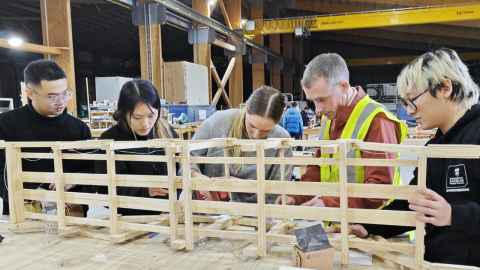Bridging innovative timber infrastructure for a low carbon future
10 August 2025
Engineers are turning to timber as a low-carbon solution for future infrastructure, with University of Auckland staff, students and alumni contributing to a global conference driving the shift.

Engineers are increasingly turning to timber as a sustainable alternative to concrete and steel in infrastructure projects, as the sector explores ways to reduce its carbon footprint and promote circular design.
New Zealand’s long-standing heritage of timber bridges and growing capabilities in wood processing and manufacturing position it as a contributor to this global shift.
From 29 June to 2 July, more than 180 delegates from over 15 countries met in Rotorua for the International Conference on Timber Bridges (ICTB), the first time the event has been hosted in the Southern Hemisphere.
Staff, students and alumni from Waipapa Taumata Rau, University of Auckland played a central role in making the conference a success. Dr Gary Raftery and Honorary Academic Hugh Morris, from the Department of Civil and Environmental Engineering, were members of the organising team and led a group of students in supporting the event.
ICTB is the leading global forum for timber bridge professionals, showcasing advances in structural design, construction, durability, asset management and sustainability. With its strong focus on efficiency, resilience and innovation, the conference continues to be a key driver of progress in timber infrastructure worldwide.
Raftery says hosting the conference in Aotearoa New Zealand provided an opportunity to showcase local capability in timber engineering and construction.
“With our heritage of timber rail and road bridges, and the capabilities we have in advanced wood manufacturing, New Zealand is well-positioned to take a global lead in sustainable timber infrastructure,” he said.

To promote the event globally, Raftery led a wide-reaching campaign that attracted participants from Australia, North America, Asia and Europe.
“Timber is a renewable, low-carbon resource, and there’s growing international interest in how we can use it to meet the infrastructure needs of the future,” he says.
At the conference, Raftery presented early-stage findings that support a more circular approach to timber infrastructure, including end-of-life design considerations and standardisation for maintainability.
Alumnus Hanshen Wang also presented research on international best practices for timber bridge service life maintenance.
A standout moment of the conference was a student bridge design challenge, coordinated by Morris at the event. Five teams of university students from across New Zealand and Australia, alongside young professionals, were tasked with designing and constructing prototype bridges.

University of Auckland students Ziyang Zhou and Qiaochu Wei teamed up with alumni Erina Tracey and Boxuan Lin to design a striking bowstring arch truss bridge. The timber prototype comprehensively exceeded its 200kg design load during live testing.
Reflecting on the experience, Zhou said working alongside young engineers offered “profound insights into the crucial difference between academic learning and practical application.”
He added that the opportunity to participate in both design calculations and hands-on construction made the experience uniquely comprehensive.
“It demonstrated how critical theoretical knowledge and adherence to standards are directly related in professional engineering practice”.
In his closing address, Morris celebrated New Zealand’s rich timber infrastructure history, from early road and rail bridges to award-winning pedestrian and cycleway structures, and encouraged delegates to continue pushing boundaries.
The conference also highlighted strategies to accelerate global adoption of sustainable timber infrastructure, with a focus on standardisation, supply chains, maintainability and design for disassembly.
Media contact
Jogai Bhatt | Media adviser
M: 027 285 9464
E: jogai.bhatt@auckland.ac.nz